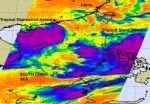(Press-News.org) The Northwestern Pacific Ocean is active with two tropical cyclones today, Tropical Storm Meari near the Philippines, and Tropical Depression Haima moving over China and now toward Vietnam. NASA's Aqua satellite passed over the region on June 22 and captured an infrared image of both storms in one image.
One of the instruments onboard NASA's Aqua satellite is the Atmospheric Infrared Sounder (AIRS). AIRS captures cloud top temperatures in tropical cyclones to determine the strength of convection and thunderstorms. The strongest thunderstorms have cloud tops with icy cold temperatures of -63F/-52C and are indicative of areas where rainfall rates could reach up to 2 inches / 50 mm per hour and both Meari and Haima had large areas of those very cold cloud top temperatures.
AIRS captured the image on June 22 at 17:53 UTC 1:53 p.m. EDT and it showed the heaviest rainfall and strongest convection (rapidly rising air that forms the thunderstorms that power a tropical cyclone) from Tropical Storm Meari is currently over the Philippine Sea and skirting the east coast of Luzon. The imagery showed the large area of strong thunderstorms (and convection) in Haima mostly over the South China Sea and Hainan Island, China.
Haima is still a tropical depression as its maximum sustained winds on June 23 at 1500 UTC (11 a.m. EDT) were near 30 knots (34 mph/55 kmh). Tropical storms have maximum sustained winds between 38 and 73 mph. It was located over Hainan Island, China, and about 235 nautical miles west-southwest of Hong Kong, China near 21.4 North and 109.6 East. Tropical Depression Haima is moving westward at 10 knots (11 mph/19 kmh).
The Joint Typhoon Warning Center does not expect Haima to strengthen into a tropical storm because of its interaction with land over Hainan Island, and its short track over the South China Sea between there and Vietnam where it is expected to make its final landfall. An orange alert in now in effect for North and South Korea as Tropical Depression Haima is tracking in that direction.
Meari is a tropical storm, and has maximum sustained winds near 40 knots (46 mph/78 kmh). It is centered to the east of Luzon, the Philippines and about 500 nautical miles south-southwest of Kadena Air Base, Japan. Meari is moving to the northwest at 12 knots (14 mph/22 kmh).
The Joint Typhoon Warning Center noted that Meari's center of circulation is elongated and there are "multiple minor vorticies developing and rotating cyclonically around the center." During the morning hours on June 23, AIRS data and microwave satellite data showed that convection has consolidated around the center, helping to better pinpoint the center in this massive storm system.
As Meari continues on a northward track it will run into cooler sea surface temperatures in the Yellow Sea, they will weaken the tropical storm quickly.
Meari's center is forecast now to remain at sea and brush Taiwan, eastern China and make landfall in the southwestern area of North Korea this weekend.
INFORMATION:
NASA's Hurricane page: www.nasa.gov/hurricane
NASA satellite gets 2 tropical cyclones in 1 shot
2011-06-24
ELSE PRESS RELEASES FROM THIS DATE:
Solar wind samples give insight into birth of solar system
2011-06-24
LOS ALAMOS, New Mexico, June 23, 2011—Two papers in this week's issue of Science report the first oxygen and nitrogen isotopic measurements of the Sun, demonstrating that they are verydifferent from the same elements on Earth. These results were the top two priorities of NASA's Genesis mission, which was the first spacecraft to return from beyond the Moon, crashing in the Utah desert in 2004 after its parachute failed to deploy during re-entry.
Most of the Genesis payload consisted of fragile solar-wind collectors, which had been exposed to the solar particles over a ...
New insights into origin of deadly cancer
2011-06-24
Boston, MA—Researchers have discovered a new mechanism for the origin of Barrett's esophagus, an intestine-like growth in the esophagus that is triggered by chronic acid reflux and often progresses to esophageal cancer. Studying mice, the researchers found that Barrett's esophagus arises not from mutant cells in the esophagus but rather a small group of previously overlooked cells present in all adults that can rapidly expand to cancer precursors when the normal esophagus is damaged by acid.
This research will be published online in the June 24th issue of Cell.
Decades ...
Study: Long-term inhaled corticosteroid use increases fracture risk in lung disease patients
2011-06-24
Patients with chronic obstructive pulmonary disease (COPD) who use inhaled corticosteroids to improve breathing for more than six months have a 27 percent increased risk of bone fractures, new Johns Hopkins-led research suggests.
Because the research subjects were mostly men age 60 and older, the findings raise perhaps more troubling questions about the medication's effects on women with COPD, a group already at a significantly higher risk than men for fractures.
"There are millions of COPD patients who use long-term inhaled corticosteroids in the United States and ...
StarChild Science: Planting Daddy's Socks
2011-06-24
Suburban Hobby Farmer asked us what was the most important lesson children have learned in a garden in my classes. My answer comes from our walks through the forest, an empty lot, a patch of earth on a farm, a small tract of woodland while wearing a pair of Daddy's socks. At the end of these walks the children plant the socks into a flat full of potting soil and a magic journey full of promise and faith begins. From here on out every child who plants their daddy's socks after walking through a forest with the socks over their tennis shoes is intimately connected to any ...
Hereditary colon cancer syndrome marked by abnormally dense blood vessel growth in mouth
2011-06-24
A team led by Johns Hopkins researchers has found that a hereditary colon cancer syndrome, familial adenomatous polyposis (FAP), is associated with abnormally dense blood vessel growth in the skin lining the mouth.
The finding, reported in the June issue of Familial Cancer, could lead to a quick screening test for FAP, which is normally diagnosed with expensive DNA tests and colonoscopies, and sometimes goes unnoticed until cancer develops.
"This higher blood vessel density in the mouth may reflect an abnormal state of cells lining the digestive tract – including the ...
Slow growth of childhood brain tumors linked to genetic process seen in skin moles
2011-06-24
Johns Hopkins researchers have found a likely explanation for the slow growth of the most common childhood brain tumor, pilocytic astrocytoma. Using tests on a new cell-based model of the tumor, they concluded that the initial process of tumor formation switches on a growth-braking tumor-suppressor gene, in a process similar to that seen in skin moles.
The findings, published in the June 1 issue of Clinical Cancer Research, could lead to better ways of evaluating and treating pilocytic astrocytomas.
"These tumors are slow-growing to start with, and sometimes stop growing, ...
Study of phytoremediation benefits of 86 indoor plants published
2011-06-24
SUWON, KOREA—Formaldehyde is a major contaminant of indoor air, originating from particle board, carpet, window coverings, paper products, tobacco smoke, and other sources. Indoor volatile organic compounds (VOCs) such as formaldehyde can contribute to allergies, asthma, headaches, and a condition known as ''sick building syndrome". The concern is widespread; a 2002 report from the World Health Organization estimated that undesirable indoor volatiles represent a serious health problem that is responsible for more than 1.6 million deaths per year and 2.7% of the global burden ...
AGU journal highlights -- June 23, 2011
2011-06-24
The following highlights summarize research papers that have been recently published in Geophysical Research Letters (GRL); Geochemistry, Geophysics, Geosystems (G-Cubed); and Paleoceanography (PA).
In this release:
Estimating climate effects of contrails
Did Aboriginal forest burning affect Australian summer monsoon?
Determining the trigger of East Asian dust storms
El Niño–Southern Oscillation variability persisted in warmer world
Constraining the trigger for ancient warming episode
Next generation atmospheric model improves hurricane forecasting
Theorized magnetic ...
New and old threats to soybean production
2011-06-24
University of Illinois researchers identified the top pathogens, pests and weeds affecting soybean production in a recent article in Food Security. Soybean aphid, soybean rust, soybean cyst nematode, Sclerotina stem rot and the exotic pathogen, red leaf blotch, were featured as some of the top biotic constraints that may affect soybean production now and in the future.
"Enormous potential exists to increase future soybean production," said Glen Hartman, U of I professor of crop sciences and USDA-ARS research scientist. "Genetic resources, used through both traditional ...
Landscape coefficients prove useful for urban water conservation efforts
2011-06-24
COLLEGE STATION, TX—Although water consumption and conservation are widely recognized as significant environmental concerns in the United States, most Americans are still unaware of the major impact of landscape irrigation on their regional water supplies. One startling example: a 2004 study of homeowners in College Station, Texas, estimated that more than 24 to 34 million gallons of excess water were used annually for landscape irrigation alone.
According to the authors of a study published in HortScience, end-users lack understanding of best management practices for ...

